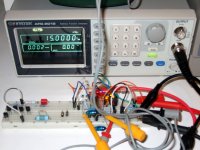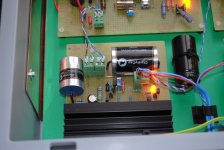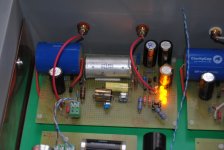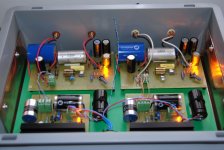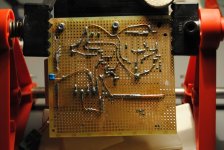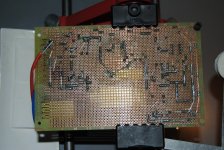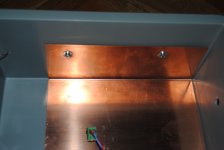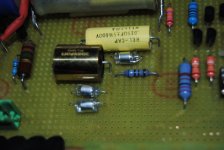Ordered some Russian caps.
OK, I played it a bit after six hours, putting a high signal through the circuit (speaker output of a radio.)
Doesn't sound bad at all. Seems lacking in the bass so far. No noticeable hum - my 300b already provides that. A good start I would say.
Gutted my Denon CD player to use the case for the RIAA and its PS. Not optimal, I know, but I will carefully separate the two compartments. I don't have the energy to build a case right now. Maybe later.
Still overhauling my 300b amps. Converting the Esmilla amp to Thorsten's Legacy with a pentode driver, and adding Rod Coleman's DC filament supplies. It's quite a bit of work, since I added three oil PS caps.
OK, I played it a bit after six hours, putting a high signal through the circuit (speaker output of a radio.)
Doesn't sound bad at all. Seems lacking in the bass so far. No noticeable hum - my 300b already provides that. A good start I would say.
Gutted my Denon CD player to use the case for the RIAA and its PS. Not optimal, I know, but I will carefully separate the two compartments. I don't have the energy to build a case right now. Maybe later.
Still overhauling my 300b amps. Converting the Esmilla amp to Thorsten's Legacy with a pentode driver, and adding Rod Coleman's DC filament supplies. It's quite a bit of work, since I added three oil PS caps.
Thanks Salas.
OOOh, I just found some more vintage RelCaps - some 15 nF for the RIAA.
Amazing what cleaning your bench can turn up. 😉
Cool... that is what I use in my builds
Speaking of relcaps.... It took me a while but I finally got things right in the "Wallis experiment".
Folded cascode input and jfet CCS in the output buffer makes the simplistic sound much more "snapy" and detailed so extreme care is needed to get the riaa filter right.
15.18nF was too spiky... 15.19nF was dull... 15.183nF is quite good.... incredible... here am I again stating I can hear pico farad differences.... but I do 🙂
Folded cascode input and jfet CCS in the output buffer makes the simplistic sound much more "snapy" and detailed so extreme care is needed to get the riaa filter right.
15.18nF was too spiky... 15.19nF was dull... 15.183nF is quite good.... incredible... here am I again stating I can hear pico farad differences.... but I do 🙂
With gen and meter shows next to textbook around the 15.2nF mark for the folded but slightly low beyond 15kHz. The gen has 0.1dB flatness spec but it should be consistently off by whatever degree in just a 20kHz band VS the 12MHz it spans. So you must be spot on saying that's optimal just below 15.2nF.
Ok, as promised here it is my subjective listening impressions report:
The "normal" simplistic provides a wide soundstage with liquid mids and highs beeing very good for complex instrumental pieces. It can produce a credible image from very complex and heavy piano pieces and excells in big orchestral moves with loads of simultaneous violins or human choruses. It is able to produce a coherent fluid picture that I consider very pleasing.
The Wallis experiment (better known as the folded cascode simplistic) has the familiar simplistic presentation but has more attack and detail in the bass. Single acoustic guitar becomes more agile and spiky. As a result, there seems to be a more analytical presentation... some hidden notes and sounds are more easily detected.
My folded cascode build is lower noise than the "normal" one but maybe that is due to the use of paralleled jfets in the input.
As I said before, the inherent higher attack and detail of the wallis makes it more sensible to the choice of the 15n cap.... (Hi can hear picos again 🙂)
As gain is quite high I neede to build a copper screen that worked wonders (after all I live in switzerland where everybody uses copper in their roofs 🙂 )
Some pictures of the spaghetti:
The "normal" simplistic provides a wide soundstage with liquid mids and highs beeing very good for complex instrumental pieces. It can produce a credible image from very complex and heavy piano pieces and excells in big orchestral moves with loads of simultaneous violins or human choruses. It is able to produce a coherent fluid picture that I consider very pleasing.
The Wallis experiment (better known as the folded cascode simplistic) has the familiar simplistic presentation but has more attack and detail in the bass. Single acoustic guitar becomes more agile and spiky. As a result, there seems to be a more analytical presentation... some hidden notes and sounds are more easily detected.
My folded cascode build is lower noise than the "normal" one but maybe that is due to the use of paralleled jfets in the input.
As I said before, the inherent higher attack and detail of the wallis makes it more sensible to the choice of the 15n cap.... (Hi can hear picos again 🙂)
As gain is quite high I neede to build a copper screen that worked wonders (after all I live in switzerland where everybody uses copper in their roofs 🙂 )
Some pictures of the spaghetti:
Attachments
As can be seen here I upgraded output caps to some new low voltage MR´s... (shortage of t$me).... The big MR´s I used for the "normal" simplistic are much much better.
The ESA caps on the shunts are slightly better the the usual MKP´s... maybe in the future I will save some t$me for obbligato gold (principaly the 10u... these really make a difference)
Now time for some more spaghetti:
The ESA caps on the shunts are slightly better the the usual MKP´s... maybe in the future I will save some t$me for obbligato gold (principaly the 10u... these really make a difference)
Now time for some more spaghetti:
Attachments
Nice shots. Having less noise than in a 48dB build normal, with a near 60dB one, no mean feat. Paralleling is just 3dB better SNR at same gain, the rest is design & execution. Copper shielding and reference to ground for 1st stage folded should have helped towards that goal. Also your total build execution is expert in those photos. Using K369s than K170s and same class caps as in the other maybe could reveal a bit more performance, but as it is its more than enough to prove that the concept works indeed. There will be proponents of the normal or folded regarding system synergy nonetheless. The normal is more configuration flexible OTOH. Like changing sensitivity easily or for combining pre pre stage. More focus and detail across the audio band can make the folded more finicky for parts, values, synergy I guess. I would consider the folded as the ''expert'' fixed build path. Is that a valid approach in your opinion RC?
Salas,
have you considered bf862 in the folded cascode version. Should perform simalarly to the 389, as it has higher yfs, as a rule. I think it may have lower ciss, as well.
have you considered bf862 in the folded cascode version. Should perform simalarly to the 389, as it has higher yfs, as a rule. I think it may have lower ciss, as well.
@buzz
That is 2SK369 high Yfs lower noise than 2SK170 and BF862. 2SK389 was just a single die K170 dual having best Tc and IDSS natural match for use mainly in differential inputs.
BF862 SMD only JFET you can use in the example that RC followed for double K170s. They are bit better but they will possibly need SMD coils in their gates if they will show any sign of oscillation. Also their D pin should be on some expanded copper area to dissipate.
@nicoch LOL, spaghetti master's approval seal, now we are blessed.😀
That is 2SK369 high Yfs lower noise than 2SK170 and BF862. 2SK389 was just a single die K170 dual having best Tc and IDSS natural match for use mainly in differential inputs.
BF862 SMD only JFET you can use in the example that RC followed for double K170s. They are bit better but they will possibly need SMD coils in their gates if they will show any sign of oscillation. Also their D pin should be on some expanded copper area to dissipate.
@nicoch LOL, spaghetti master's approval seal, now we are blessed.😀
As can be seen here I upgraded output caps to some new low voltage MR´s... (shortage of t$me).... The big MR´s I used for the "normal" simplistic are much much better.
the bigger the better 😛 Hight V sound better ,unlucky....
btw Ricardo so much ?
@Nick 😀
Last edited:
Ahh. THats right. Scott Wurcer did the test, didnt he.@buzz
That is 2SK369 high Yfs lower noise than 2SK170 and BF862. 2SK389 was just a single die K170 dual having best Tc and IDSS natural match for use mainly in differential inputs.
BF862 SMD only JFET you can use in the example that RC followed for double K170s. They are bit better but they will possibly need SMD coils in their gates if they will show any sign of oscillation. Also their D pin should be on some expanded copper area to dissipate.
@nicoch LOL, spaghetti master's approval seal, now we are blessed.😀
Yes... definitely more finicky for parts, specially the riaa filter, it took me a while to get it working properly (but as always, hard work pays).Nice shots. Having less noise than in a 48dB build normal, with a near 60dB one, no mean feat. Paralleling is just 3dB better SNR at same gain, the rest is design & execution. Copper shielding and reference to ground for 1st stage folded should have helped towards that goal. Also your total build execution is expert in those photos. Using K369s than K170s and same class caps as in the other maybe could reveal a bit more performance, but as it is its more than enough to prove that the concept works indeed. There will be proponents of the normal or folded regarding system synergy nonetheless. The normal is more configuration flexible OTOH. Like changing sensitivity easily or for combining pre pre stage. More focus and detail across the audio band can make the folded more finicky for parts, values, synergy I guess. I would consider the folded as the ''expert'' fixed build path. Is that a valid approach in your opinion RC?
I also forgot to mention, it takes a while to reach propper working voltages after turn on, due to the special folded cascode biasing.
Maybe I should try the 2SK369... where can I get those ?
Can I use this actual build without major modifications ?
Last edited:
Yes... that much.the bigger the better 😛 Hight V sound better ,unlucky....
btw Ricardo so much ?
The big ones convey a much larger sounstage... overall presentation has much more poise.
Yes... definitely more finicky for parts, specially the riaa filter, it took me a while to get it working properly (but as always, hard work pays).
I also forgot to mention, it takes a while to reach propper working voltages after turn on, due to the special folded cascode biasing.
Maybe I should try the 2SK369... where can I get those ?
Can I use this actual build without major modifications ?
Its in conjunction with how fast the PSU settles and how fast the bias in the input JFET(s) settles. Could speed up if it was a BIB powering.
It would need enough modifications for 369s. I already posted a 57dB using just one. Which is same noise as with 2xK170 with an advantage in the mids to lows 1/F area though. Two would make it too strong for your carts. VGeorge hit on fakes on first try sourcing on ebay he told me.
Second try on ebay for the 369 was fine. Try to find some that are on tape. Less likely to be fakes. Out of 10 pieces I managed to find two pairs.
Very nice work though Riccardo!
Very nice work though Riccardo!
- Home
- Source & Line
- Analogue Source
- Simplistic NJFET RIAA
